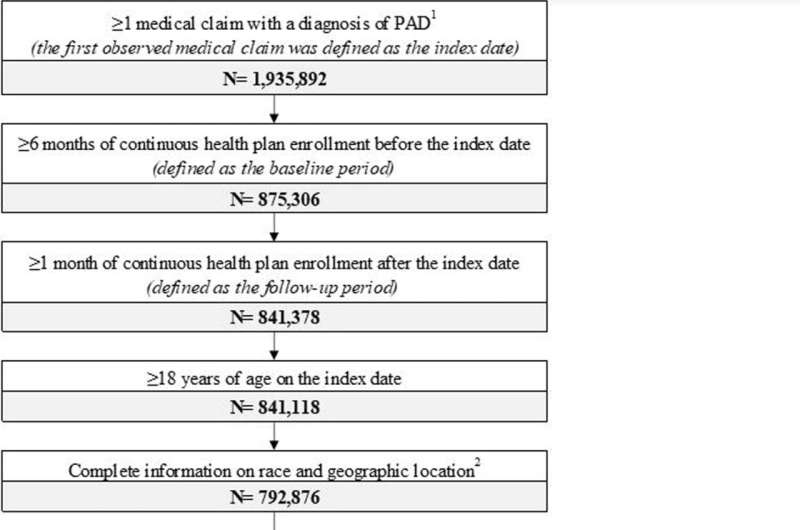This article has been reviewed according to Science X's editorial process and policies. Editors have highlighted the following attributes while ensuring the content's credibility:
fact-checked
trusted source
proofread
Black patients with plaque build-up in arteries in the legs more likely to have a stroke, heart attack or amputation

A new study from Keck Medicine of USC has uncovered significant racial disparities in the diagnosis, treatment and outcomes of peripheral artery disease (PAD) among Black and white patients in the United States.
PAD, which affects approximately eight to 12 million Americans and is associated with nearly half of the 150,000 yearly amputations in the U.S., is a potentially life-threatening condition in which the arteries that carry blood from the heart to the legs narrow or become blocked by the buildup of fatty plaque. This can lead to a heart attack, stroke or amputation of the affected limb.
"We discovered that Black patients are nearly 50% less likely to receive vascular interventions to potentially restore the blood flow than white patients, and consequently are at a disproportionately higher risk of a stroke, heart attack or amputation," said David Armstrong, DPM, Ph.D., a podiatric surgeon specializing in limb preservation with Keck Medicine and an author of the study.
"Additionally, Black patients tend to have more advanced PAD and are sicker at the time of diagnosis, indicating they may not be getting as timely medical attention as their white counterparts."
PAD often starts out with no or mild symptoms, such as a leg cramp or muscle pain, and therefore often goes underdiagnosed.
Once detected, generally through a blood test, PAD is typically treated with medication to reduce the plaque in the arteries and through suggested lifestyle changes, such as increased exercise and a healthy diet. If these measures don't work, physicians usually recommend a procedure known as revascularization. Revascularization either improves the blood flow to the arteries by using a balloon or stent to open them or reroutes the blood to another, healthier artery, which can reduce the risk of a cardiac incident or amputation.
The study discovered that Black patients are more likely to only receive medication and lifestyle change recommendations, while white patients also receive revascularization. "Our findings suggest Black patients are missing out on potentially limb- and life-saving treatments," said Armstrong. "And because Black patients tend to be sicker at the time of diagnosis than white patients, they may actually be in more need of a revascularization than other patients."
Armstrong and his colleagues used a large national database to compare rates of diagnostic testing, treatment patterns and outcomes after diagnosis of PAD among commercially insured patients in the United States from the years 2016 to 2021. They identified some 455,000 white patients and 96,000 Black patients.
They then compared demographics, markers of disease severity and health care costs as well as patterns of medical management and rates of amputation and cardiovascular events among the two patient groups to reach their conclusions.
While the study did not analyze why disparities in the detection, treatment and outcomes of PAD between Black and white patients exist, one factor may be that Black patients are already at a higher risk of developing PAD, said Armstrong. He also hypothesizes that the inequalities may be due to broader systematic issues in health care such as unconscious bias or barriers to health care access for certain populations.
"We hope this study will encourage physicians to take these differences into account when diagnosing and treating PAD to ensure that vascular interventions are being equally provided to all patients," he said. "We also urge health professionals to offer more routine screenings for PAD in Black patients."
Additionally, Armstrong advises patients to proactively seek medical advice and testing if they have any symptoms related to PAD—leg cramping, pain, numbness, weakness or discoloration—and advocate to be considered for all treatment options after diagnosis.
The research is published in the journal Advances in Therapy.
More information: Keith C. Ferdinand et al, Real-World Racial Variation in Treatment and Outcomes Among Patients with Peripheral Artery Disease, Advances in Therapy (2023). DOI: 10.1007/s12325-023-02465-6





















